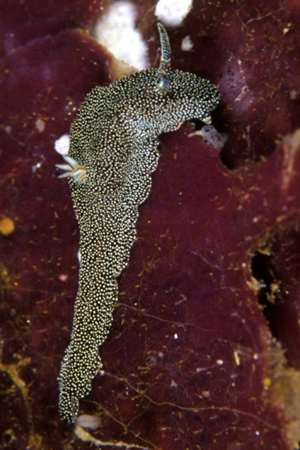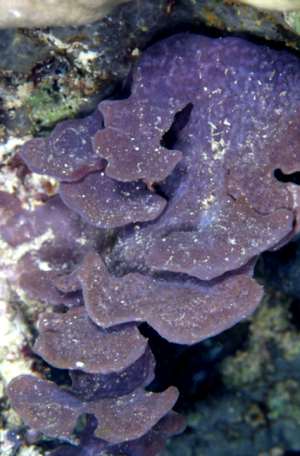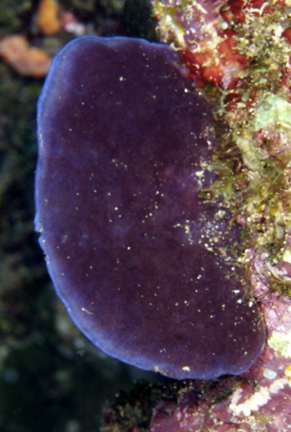Glossodoris stellatus in Papua New Guinea [1]
April 18, 2005
From: Mary Jane Adams

Dear Bill,
After making hundreds of dives in Papua New Guinea without seeing a single Glossodoris stellatus, I thought they must be really rare. I recently learned that I just wasn't looking in the right place. On a trip to Milne Bay in October 2004 I asked PNG diving pioneers Bob and Dinah Halstead if they knew where I might find this species. They told me that they lived on the underside of a certain foliose sponge. With that information I was able to find dozens of them on reefs around the D'Entrecasteaux Islands and along the North Coast of Milne Bay. The sponge is very common and easy to recognize. The upper side is purple, but sometimes appears gray or green due to overgrowth of algae, hydroids, etc. The underside is darker and more reddish purple. The sponges are quite tough and leathery, but flexible enough to bend easily in a slight current. Some colonies grow strait out from the reef in a semi-circle. (lower right) Other colonies have a relatively narrow base that branches into many lobes. (lower left).
Although these sponges were seen on most divesites in Milne Bay, the ones where I found G. stellatus were on vertical or nearly vertical walls. The sponges that had G. stellatus under them were fairly clean. I never saw any G. stellatus on sponges that were heavily overgrown with other organisms. The highest concentration of G. stellatus I saw was on Balaban's Bommie near the northwest corner of Normanby Island. On this divesite there was a dense cluster of these foliose sponges on a vertical wall. On 22 Oct. 2004, I found G. stellatus under about 15% of these leafy sponges at a depth of 10-15 meters. A few sponges had two slugs and one had four. [see #13506 ]. Even in areas with a high concentration of G. stellatus, I never saw any that weren't on sponges, however Mike Miller did find one crawling on rubble patch near Sanaroa Island.
The Glossodoris stellatus specimens I saw all looked nearly alike. They were dark brown to charcoal black with tiny, close-set, white dots and a crawling length of 50 -70 mm. I also saw many yellow egg coils on the underside of the host sponges. I never observed a slug laying these eggs, but another diver in my group did. The coils measured 20-24 mm across and as best as I can measure, the eggs are about 170 microns in diameter [see #13506 ].
The slugs seemed to be grazing on the sponge, but I couldn't tell for sure underwater. However, one of my photos (upper right) shows a patch of sponge near the anterior end of the slug that appears to have been scraped away. The fact that they prefer bare sponges to those with other organisms growing on them indicates to me that the sponge itself is their food. The slugs were always on the underside, near the center or base of the sponge where they were best concealed. However, their egg coils were always very near the edge of the sponge where they would be exposed to the most water movement. When I pulled specimens off the sponges I noticed that they held on with a Velcro-like grip that had to be peeled away bit by bit. A sticky foot is certainly useful for a slug that lives its life upside down. In one photo [see #13506 ] I noticed two rows of light brown spots on the mantle. Are these are poison glands?
Locality: Milne Bay Province, Papua New Guinea, Pacific Ocean. Depth: 10-25 meters. Length: 50 -70 mm. Oct. 2004, Jan. 2005. Coral Reef. Photographer: M. J. Adams.
Best regards,
Mary Jane
divepng@yahoo.com


Dear Mary Jane,
Thanks for this valuable information. This sort of knowledge about individual species is not available in textbooks and seldom found in scientific papers. I am sure the marks you can see are signs of it feeding, and its constant association with this sponge is a good indication that this is indeed its food sponge. I am pleased to say our sponge identification exercise is very close to completion, and finding G. stellatus on this sponge complements the data we have on Glossodoris species.
The light brown spots in two rows in your photo [see #13506 ] are indeed the mantle [poison] glands. This is an interesting addition to our knowledge as I was unable to find the glands in earlier studies (Rudman, 1986). In that study I could divide the species of the genus Glossodoris into at least 3 subgroups on the basis of various external and internal anatomical features. Glossodoris stellatus belonged in the 'G. atromarginata subgroup' on the basis of general shape (hardened body, reduced mantle skirt, radular morphology etc). It is nice to see that the position and type of mantle glands is identical to that of G. atromarginata, certainly supporting the possibility that the genus Glossodoris may need an overhaul when we have more material available.
Best wishes,
Bill Rudman
Related messages
-
Glossodoris stellatus from Sulawesi
From: Ken Tucker, February 6, 2007 -
Re: Glossodoris stellatus in Papua New Guinea
From: Roberto Sozzani, July 13, 2005 -
Glossodoris stellatus in Papua New Guinea [2]
From: Mary Jane Adams, April 18, 2005 -
Glossodoris stellatus from Sipadan, Malaysia
From: Alice Lee, June 24, 2003 -
Re: Glossodoris stellatus
From: David Harasti, February 25, 2003 -
Glossodoris stellatus from Tufi, Papua New Guinea
From: Dave Harasti, February 24, 2003 -
Glossodoris stellatus from Bunaken
From: Mirta Moraitis, May 4, 2002
